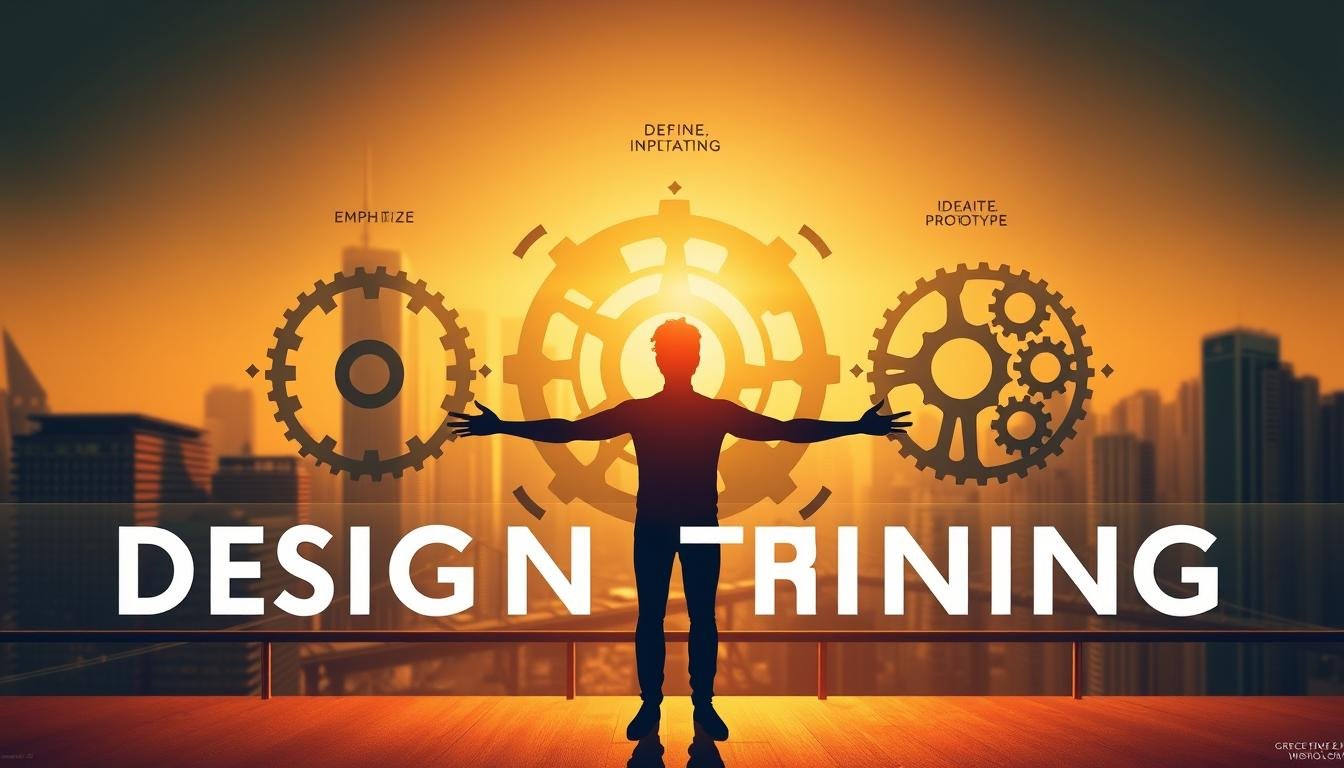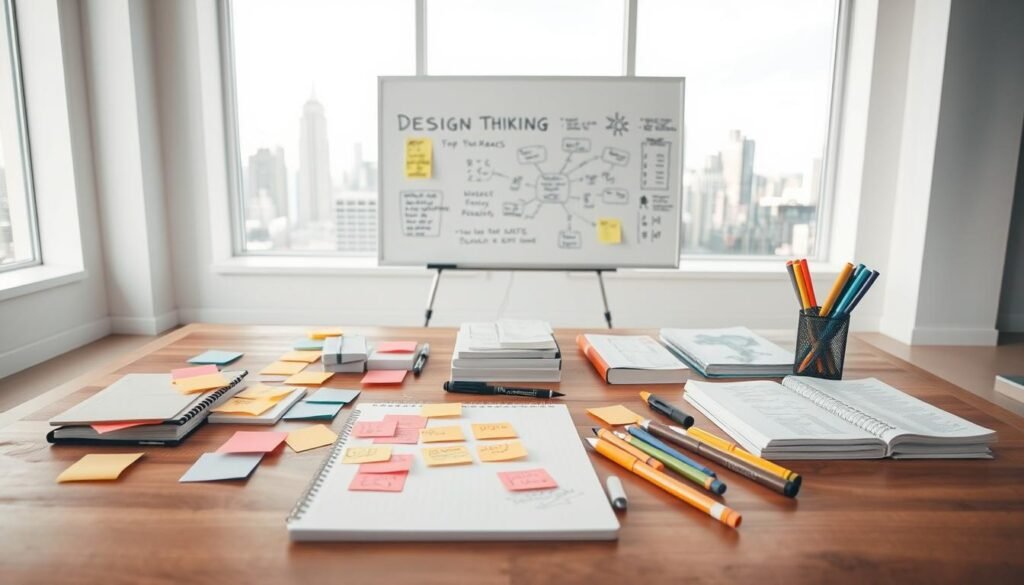Now Reading: Unlock Exceptional Business Innovation with Design Thinking
-
01
Unlock Exceptional Business Innovation with Design Thinking
Unlock Exceptional Business Innovation with Design Thinking

Unlock Exceptional Business Innovation with Design Thinking
Design thinking is key for modern innovation. Companies like Apple and IBM use it to stay ahead. This problem-solving approach focuses on understanding human needs, not just making money. It creates solutions that really connect with people.
Old ways often miss the mark, leaving chances unexplored. But, using design thinking leads to 34% higher customer satisfaction and 50% quicker product launch. So, what makes it so powerful?

Key Takeaways
- Design thinking prioritizes empathy and iterative testing over assumptions.
- Companies using this innovation methodology see measurable gains in market differentiation.
- It challenges conventional business strategies by centering user experiences.
- Over 70% of Fortune 500 firms now integrate design thinking into R&D processes.
- Adopting this problem-solving approach reduces risks by validating ideas early.
Understanding the Foundations of Design Thinking
Design thinking came about as a way to fix old problem-solving approaches that didn’t care about people’s needs. It’s a new way of working that puts empathy and teamwork first. This has changed how companies face challenges.
The Evolution of Design Thinking Methodology
It started at Stanford University’s d.school in the 1990s. By the 2010s, big names like Apple and Google were using it. Here are some important moments:
- 1991: d.school starts using human-centered design
- 2008: Tim Brown’s Change by Design makes it more popular
- 2020s: It becomes a big deal in many industries
Key Principles That Drive Innovation
| Principle | Description |
|---|---|
| Empathy | Understanding user pain points through observation |
| Iteration | Prototyping and testing ideas rapidly |
| Cross-functional collaboration | Bringing diverse perspectives together |
Why Traditional Problem-Solving Falls Short
“The old ways assume one-size-fits-all solutions,” explains IDEO’s core philosophy. Traditional methods prioritize efficiency over empathy, neglecting evolving user needs.
Design thinking is different. It uses innovation by testing and involving everyone. It’s not about following a straight line. It’s about finding new ways by embracing the unknown.
The Five Stages of Design Thinking in Business
Design thinking turns ideas into real solutions. It uses a problem-solving approach with five key stages. These stages help businesses understand what users need and improve their products.
- Empathize: Start by watching how users behave and what they need. Companies like Airbnb use surveys and interviews to find out what users really want. This makes sure solutions meet real needs.
- Define: Take what you’ve learned and make a clear problem statement. For example, Samsung’s teams turn customer complaints into specific goals, like making things easier for seniors.
- Ideate: Think freely to boost creativity. IBM holds “jam sessions” where employees come up with lots of ideas. This encourages teamwork over criticism.
- Prototype: Create simple models to test ideas. Toyota uses 3D printing to quickly make car designs. They then change them based on what people say.
- Test: Try out solutions with real users. Google’s Project Aristotle tests team tools over and over until they’re just right.
“The value of design thinking isn’t just in the process—it’s in the mindset it cultivates.” — IDEO
Every stage goes back to understanding users. This keeps innovation focused on people. It shows design thinking is more than just a theory. It’s a way to grow a business.
How Design Thinking Transforms Business Innovation
Design thinking changes how businesses innovate by tackling big problems and creating flexible plans. It turns obstacles into chances for growth. This leads to better teamwork, creativity, and focus on customers.
Breaking Down Organizational Silos
Companies focus on innovation to break down old ways of working. Teams from different areas work together from the start. For example, IBM saw a 30% drop in project delays thanks to these joint efforts.
Cultivating a Culture of Creativity
- Weekly brainstorming sessions encourage diverse ideas.
- Prototyping tools like Figma enable iterative testing.
- Recognition programs reward creative risk-taking.
Shifting to Human-Centered Approaches
| Traditional Approach | Human-Centered Design |
|---|---|
| Data-driven assumptions | User research insights |
| Internal metrics | Customer feedback loops |
| Product-centric timelines | Iterative development cycles |
Companies like IDEO make solutions 40% faster by focusing on what users need.
Accelerating the Innovation Pipeline
Quick prototyping and testing speed up development. For instance, LEGO cut its product launch time by 25%. The key steps are:
- Validate concepts with prototypes.
- Test with real users.
- Iterate based on feedback.
“Innovation thrives where curiosity meets collaboration.” — Stanford d.school
Developing an Exceptional Vision Through Design Thinking
Every innovation starts with a vision that mixes dreams with real plans. Design thinking helps teams create visions that are creative and solve real problems. This way, companies can turn big ideas into things they can measure.

Techniques for Crafting Forward-Thinking Business Strategies
- Future-state mapping: Visualizing desired outcomes through collaborative workshops
- Scenario planning: Testing potential futures to identify strategic opportunities
- Vision boarding: Combining visuals and narratives to clarify goals
Aligning Teams Around a Common Purpose
“A shared vision reduces friction and accelerates execution.” – Harvard Business Review, 2023
Design thinking workshops help teams talk across departments. Tools like mind-mapping sessions make sure everyone’s voice is heard. This builds agreement before starting work.
Translating Vision into Actionable Innovation Roadmaps
- Define 3–5-year milestones tied to strategic goals
- Segment plans into quarterly deliverables with measurable KPIs
- Assign ownership of each phase to specific teams
Companies like IDEO use this method to make big ideas into plans. These plans are ambitious but also realistic. This way, creativity leads to real results.
Inspiring Creative Solutions with User-Centered Research
User-centered design changes how we innovate by finding needs we didn’t know existed. It uses human-centered design to move from guesses to real insights. Ethnographic studies, empathy interviews, and journey mapping uncover chances missed by old ways of surveying.
“The best design solutions emerge when we listen to people’s real behaviors, not just their words.” — Don Norman, User Experience Pioneer
Effective methods include:
- Ethnographic studies observing users in natural settings
- Contextual inquiry to analyze task workflows
- Journey maps visualizing customer pain points
| Traditional Research | User-Centered Design |
|---|---|
| Focus groups and surveys | Contextual observations |
| Quantitative metrics | Qualitative empathy |
| Product-driven insights | Need-based discoveries |
Teams use findings to make patterns with tools like affinity diagrams or personas. Companies like Airbnb use this to make their platforms better for travelers. By focusing on what people need, design thinking makes solutions that feel right and work well. This research phase guides teams to real breakthroughs without making things too complicated.
Practical Tools to Motivate Design Thinking in Your Organization
To make design thinking work, you need the right tools. Companies do well by picking frameworks and platforms that match their goals. This creates spaces where creativity and teamwork can grow.

Workshop Frameworks That Drive Engagement
Workshops get teams excited. Innovation sprints, like IDEO’s Design Sprint, pack problem-solving into 5 days. Innovation jams and design challenges at Google boost creativity with rewards.
These methods turn big ideas into steps you can take.
Digital Collaboration Platforms for Remote Innovation
Teams working together need tools like Miro for brainstorming and Figma for making prototypes. These tools help teams work together, even from far away. Slack and digital boards keep ideas moving, no matter where you are.
Documentation Methods for Capturing Insights
Tools like Notion or Confluence keep workshop results in one place. They use tags and boards to organize ideas. Adobe XD’s cloud lets teams keep track of their work, so nothing gets lost.
“The right tools don’t just support design thinking—they become the backbone of institutional memory,” says Stanford d.school’s 2023 report on organizational change.
Using these tools helps teams work faster and smarter. They connect creativity with business goals. With good documentation and tech, companies can keep innovating.
Building Teams with a Natural Flair for Design Thinking
Design thinking works best when teams have both natural talent and training. Here’s how companies help teams become creative and innovative.
“She has a flair for designing user-friendly interfaces.”
Identifying Design Thinkers in Your Organization
Find employees who love to question things and care about others. Look for signs like:
- They’re curious about what users struggle with.
- They’re okay with trying things over and over.
- They talk about solving problems in a way that focuses on people.
Training Programs to Develop Innovation Capabilities
Learning in a structured way helps people grow. Good ways to learn include:
- Workshops where you practice things like mapping out user journeys.
- Online courses from places like creativity labs at IDEO U.
- Programs where newbies learn from more experienced people.
Cross-Functional Innovation Teams
Mixing different roles can make teams stronger. A good team has:
| Role | Key Skills | Innovation Impact |
|---|---|---|
| Facilitator | Conflict resolution | Streamlines decision-making |
| UX Researcher | User empathy mapping | Uncovers unmet needs |
| Technical Lead | Prototyping tools | Accelerates concept testing |
Teams like this break down barriers and boost everyone’s creativity.
The Iterative Process: Prototyping and Customer Feedback
The iterative process is at the core of design thinking. Each prototype, whether a sketch or a working model, is used to test ideas and get customer feedback. This cycle of making, testing, and improving ensures solutions meet user-centered design standards. It turns abstract ideas into real, useful innovations.
- Low-fidelity prototypes: Paper sketches or basic models for early-stage validation
- Mid-fidelity: Digital mockups to assess usability and functionality
- High-fidelity prototypes: Near-final versions tested for real-world conditions
Getting good feedback needs a structured approach. Surveys, usability tests, and A/B testing are key. But, avoiding pitfalls like ignoring feedback that goes against your initial thoughts is crucial. Teams should test with diverse groups to find all user needs.
Top brands like Apple and IDEO make iteration a key part of their work. For example, IDEO’s work on hospital equipment involved over 20 prototype changes. These were shaped by feedback from nurses and patients. This user-centered design cut development time by 40% and boosted adoption.
Every step in the process turns feedback into action. By seeing each prototype as a learning step, not the end goal, teams lower risks and speed up innovation. This leads to solutions that really connect with users and stand out in the market.
Measuring the Impact of Design Thinking on Business Outcomes
Figuring out the worth of design thinking means linking metrics to company goals. Leaders need to mix innovation results with financial gains. This helps show the value of focusing on people in problem-solving.
Key Performance Indicators for Innovation Initiatives
Good KPIs look at both how things are done and the results:
- Process: How many ideas are made, how many prototypes are tried, and how often teams work together
- Outcome: How much new product sales are, how happy customers are, and how fast products hit the market
Quantitative vs. Qualitative Evaluation Methods
| Method | Examples | Strengths |
|---|---|---|
| Quantitative | ROI calculations, Net Promoter Scores | Objective benchmarks for funding decisions |
| Qualitative | User interviews, team retrospectives | Reveals unmeasured opportunities |
“Qualitative insights often predict future innovation potential better than spreadsheets,” says Stanford d.school’s 2023 research.
Communicating Success to Stakeholders
Good storytelling mixes data with stories:
- Show executives how much money is saved compared to R&D costs
- Share what customers say with the teams that work with them
- Make visual dashboards to compare before and after metrics
Apple’s 2022 product launch shows how tracking usability and sales growth proves design thinking’s worth. Using the same measurement tools helps avoid quick judgments. It also helps grow innovation over time.
Overcoming Common Challenges in Design Thinking Implementation
Starting design thinking can face hurdles like resistance from stakeholders and keeping the momentum. Teams might find it hard to add it to their current work or grow it beyond small tasks. But, these challenges can be chances for growth. Here’s how groups can overcome them.
“Collaboration and iterative testing turned skepticism into support,” said a manager at a Fortune 500 tech firm. Their team overcame resistance by involving skeptics early in prototyping phases.
A problem-solving approach based on empathy tackles three main hurdles:
- Resistance to Change: Share success stories from early projects. Show how innovation improves customer happiness or efficiency.
- Losing Momentum: Have regular feedback sessions and celebrate small victories. Public praise encourages teams to keep going.
- Process Integration: Match design thinking steps with current work processes. For example, tie ideation sessions with quarterly plans.
Support from colleagues boosts involvement. Pair newcomers with mentors who’ve successfully applied design thinking. Training that focuses on quick prototyping also boosts confidence. Remember, sticking with it is crucial. Even big names like IDEO kept improving their methods, showing that adapting leads to lasting success.
Starting design thinking takes time. By tackling these challenges directly, companies can achieve lasting innovation and change how they solve problems.
Conclusion: Embracing Design Thinking as a Competitive Advantage
In today’s markets, design thinking is key for innovation. Companies that focus on users do better than others. They grow by solving problems with empathy and staying quick to change.
Big names like Apple and Google use design thinking to innovate fast and connect with customers. New tech like AI will make this approach even stronger. Tools like Miro and Figma make teamwork easier, and resources from IDEO and Stanford’s d.school offer clear steps for teams.
Starting with design thinking is easy. Just begin with workshops and training. You’ll see real benefits, like saving money and launching products faster. Companies that put users first will lead the way.
The future is for those who mix empathy with creativity. By making design thinking a part of their work, businesses can turn problems into chances. It starts with being curious and working together. The choice to innovate with design thinking is not just a good idea—it’s necessary to succeed.
FAQ
Q: What is design thinking?
A: Design thinking is a way to solve problems by understanding what users need. It encourages creativity and uses an ongoing process to find solutions. This method focuses on empathy and teamwork to create innovative solutions.
Q: How does design thinking differ from traditional problem-solving methods?
A: Design thinking puts people at the center, unlike traditional methods that focus on technical solutions. It emphasizes understanding users and creativity, leading to more innovative solutions.
Q: What are the key stages of the design thinking process?
A: The design thinking process has five main stages: Empathize, Define, Ideate, Prototype, and Test. Each stage helps teams understand users, define problems, come up with ideas, create prototypes, and test them. This process encourages continuous improvement.
Q: How can customer feedback be effectively integrated into design thinking?
A: Customer feedback is key throughout the design thinking process. Using empathy interviews, surveys, and usability testing can provide valuable insights. These insights help improve solutions, ensuring they meet user needs.
Q: What role does creativity play in design thinking?
A: Creativity is crucial in design thinking. It allows teams to think outside the box and come up with new ideas. By encouraging creativity, organizations can find innovative solutions to complex problems.
Q: How can organizations foster a culture conducive to design thinking?
A: To foster innovation, organizations should encourage teamwork and provide training. They should also reward creative efforts. Setting up workshops that engage teams helps integrate design thinking into daily work.
Q: Why is the iterative process important in design thinking?
A: The iterative process helps refine ideas based on feedback and testing. It allows organizations to learn and improve quickly. This leads to successful innovations that meet real user needs.
Q: What are some common challenges businesses face when implementing design thinking?
A: Businesses often struggle with resistance to change and integrating design thinking into existing processes. Scaling initiatives can also be a challenge. Overcoming these obstacles requires a supportive environment and encouragement.
Q: How can design thinking lead to exceptional business outcomes?
A: Design thinking aligns innovation with real user needs. This leads to happier customers, lower costs, and greater agility. It drives success by encouraging feedback and fostering a creative, collaborative culture.






























